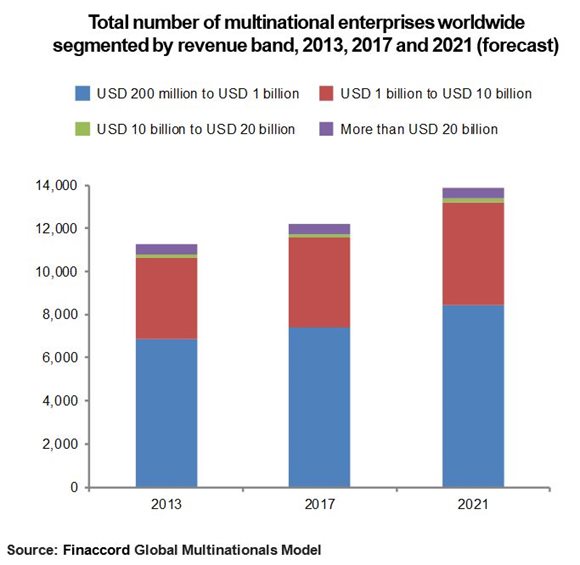PRESS RELEASE
Global Multinationals and Corporate Transferees: A Worldwide Review
Download the PDF version of this press release here.
London, 9 November 2017 – The global trend for international mobility looks set to continue as smaller and medium-sized multinationals, in particular, drive growth and encourage greater movement of employees around the world. This is a key finding from a new study incorporating unique analysis from Finaccord, a division of Aon Inpoint, whose report Global Multinationals and Corporate Transferees: A Worldwide Review reveals that the number of multinationals worldwide is on course to reach 13,900 by 2021 while the number of employees who are classed as expatriate or corporate transferees will exceed 1 million.
David Bowles, Consultant at Finaccord, highlights some of the main trends identified by the report: “Smaller corporations turning over up to US$ 10 billion per annum account for the vast majority of all multinationals as they make up 94.6 percent of the total in 2017. Thus, ‘mega multinationals’ with annual revenues in excess of US$ 10 billion make up the residual 5.4 percent. At a respective 18.3 percent and 17.8 percent of all enterprises, the financial and retail / wholesale sectors produce the most multinationals followed by manufacturing of consumer goods, at 9.3 percent.”
Multinationals based in the Asia-Pacific region are producing the most ‘global employees’…
However, despite being relatively few in number, ‘mega multinationals’ are estimated to generate more than two thirds (67.1 percent) of the total number of expatriate and other corporate transferees employed by multinationals.
Continues David Bowles: “Among all multinationals globally, our analysis indicates that enterprises in two sectors – namely, energy and power plus professional services – are particularly significant, and that corporate transferees are being generated most rapidly by enterprises based in the Asia-Pacific region. In fact, the top five enterprises by this measure are all headquartered in the Asia-Pacific region: Tata Group employs the most such transferees followed by two other India-based enterprises, Infosys and Wipro, and then by the state-owned China National Petroleum and Taiwan-based manufacturing group Foxconn. In total, there are likely to be more than 1 million expatriate and other corporate transferees employed by multinationals by 2021.”
… whose number has been growing at a compound annual rate of over 4 percent
Overall, there were a total of around 12,230 multinational enterprises worldwide with revenues of at least US$ 200 million in 2017 and their number increased at a compound annual rate of 2.0 percent between 2013 and 2017. Furthermore, there were around 838,600 expatriate and other corporate transferees employed by these multinationals in 2017 and, given a compound annual rate of 4.1 percent since 2013, this number has been growing at a faster rate than the number of multinational enterprises as a result of the increasing trend for international mobility.
The rise in number of medium-sized multinationals has been most rapid
Adds David Bowles: “We defined the concept of a ‘multinational enterprise’ as comprising any for-profit organisation, including state-owned entities, that has annual revenues of at least US$ 200 million, that has substantial operations via subsidiaries and / or branches in at least one country outside the country of its headquarters, and that, in order to avoid double-counting, is not majority-owned by any other corporate entity.”
“Although many enterprises operating in the technology, media and telecoms sector are growing at a relatively rapid rate in terms of their total revenues, they only make up 2.5 percent of the total number of multinationals worldwide and are outnumbered by those from numerous other sectors including chemicals, energy and power, professional services and even general conglomerates, to name a few.”
In addition, the research established that the fastest growth in the number of multinational enterprises is occurring among those with annual revenues of between US$ 1 billion and US$ 10 billion, and among those headquartered in Africa or the Asia-Pacific region (especially China). In contrast, it is likely that the number of multinational enterprises with revenues of over US$ 20 billion has fallen slightly in recent years, a trend that can be attributed to mergers and acquisitions as well as individual company performance. Looking ahead, Finaccord calculates that the rate of growth in the number of multinational enterprises worldwide is likely to be 3.2 percent between 2017 and 2021, resulting in a total of almost 13,900 by 2021.
--- ENDS ---
Media contact: Amandas Ong, +44 (0) 207 086 1336, [email protected]
Notes to editors:
Finaccord is a market research, publishing and consulting company specialising in financial services. is part of Aon Inpoint, Aon Risk Solutions, a business unit of Aon plc (NYSE: AON). It provides its clients with insight into and information about major issues in financial services around the world, with a particular focus on marketing and distribution topics such as affinity marketing, bancassurance and strategic alliances.
Finaccord’s report titled Global Multinationals and Corporate Transferees: A Worldwide Review is a report and associated MultinationalBASE™ dataset about multinational enterprises around the world and the expatriate and other corporate transferees who are employed by them. It provides data about both multinationals and corporate transferees segmented by annual revenues, region of headquarters and industry sector. In addition, in the MultinationalBASE™ dataset, rankings are provided for the world’s leading 730 multinationals by various criteria, namely: total revenue; revenue outside country of headquarters; growth (or decline) in total revenues; percentage of total revenue outside country of headquarters; percentage of total employees outside country of headquarters; and number of employees that are expatriate or other corporate transferees. While the study as a whole is representative of all 12,230 multinationals worldwide in 2017, the list of 730 leading multinationals profiled in detail can be viewed here.
